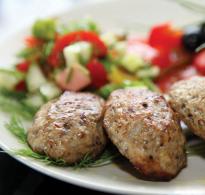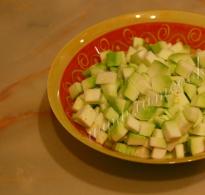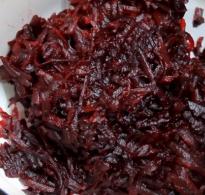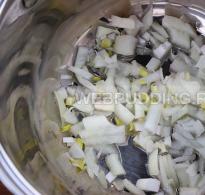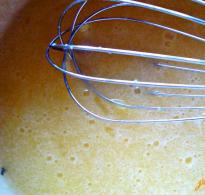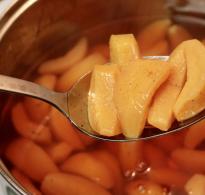Rhubarb: cooking recipes. What dishes can be prepared from rhubarb? What can be prepared from it?
Rhubarb is a perennial plant with large leaves that grows in the middle zone. Its edible part is greenish-red petioles, fleshy and juicy. Rhubarb leaves are not suitable for food, but many delicious dishes can be made from the petioles. Do you already know how to cook or pie with it? Believe me, there will be options that will surprise you.
From this plant, which is a vegetable from a botanical point of view, you can make marmalade, jelly, compote, jam, pie filling, cream soup, vinaigrette and sauces. The main thing is not to use brass or metal utensils while cooking, as rhubarb can lead to an oxidative reaction. Now you know what you can cook from rhubarb. By the way, this vegetable appears when you can’t even think about other fresh fruits and berries, and becomes an excellent source of vitamins and healthy acids and salts. As a medicinal remedy, rhubarb is used as a natural mild laxative. For people with gastrointestinal problems or dieters, this property is really valuable. Let's talk in more detail about what can be prepared from rhubarb.

Compote with rhubarb
Take a kilogram of petioles, wash them thoroughly and cut them into pieces a couple of centimeters long. Pour in a liter of water and boil for five to seven minutes. To taste, you can add no more than one and a half glasses of sugar, after which you should cook until the petioles soften. If desired, you can add vanillin or vanilla sugar, as well as cinnamon. The taste will be more piquant. This easy-to-make and delicious compote will take the guesswork out of thinking about what you can make with rhubarb.
Kissel with rhubarb
Unlike compote, jelly is thicker and more nutritious. Didn’t you know that you can also make jelly from rhubarb? This is true. To prepare, you need a kilogram of petioles, cut into small pieces, a liter of water, sugar, or cinnamon. Boil the roots for five minutes, rub through a sieve or puree with a blender, add sugar, vanillin and zest or cinnamon. Stir five tablespoons of starch in cold water and, stirring slowly, pour in the rhubarb puree. Heat the mixture to a boil and turn off the heat. Let the jelly cool and serve as a dessert.

Rhubarb sauce
What can be made from rhubarb that is even more unusual? This is the sauce. Take the petioles cut into pieces and boil them until soft. Grind through a sieve or in a blender. Fry some flour in oil, add sour cream, salt, sugar and pureed puree, heat to a boil. This sauce goes well with meat dishes instead of tomato paste. The ratio of products is as follows: for one and a half kilograms of petioles you need to take two teaspoons of flour, one hundred or two hundred grams of sour cream to taste, a teaspoon of salt and a tablespoon of sugar. Rhubarb is also suitable as a dressing. For example, an ordinary vegetable vinaigrette will become more piquant and unusual if you season it with juice from boiled petioles. Boiled rhubarb can be added to soups instead of spinach or sorrel.
We have no problem with what to cook from rhubarb - there are more than three dozen recipes.
Friends, good day! With you, Victor Dulin.
Rabarbara is the name given to rhubarb in Estonia; we started one of the first ones at our dacha back in 1988.
It was grown from seeds and rhizomes donated by summer residents we knew, many older than us.
Or rather, in exchange for our science of vermicultivation, vermicompost and the technological earthworms themselves.
Since then, from early spring to late autumn, huge leaves, flowers and seeds of this plant decorate the garden on the north side of the eco-house.
But the giant stems, amazing for us, reaching the thickness of my hand at the wrist, are not only highly decorative, but were also immediately used as a filling for sweet pies - according to many popular Estonian and other recipes.
All year round, such pies can be purchased here in almost all cafes and shops, since pieces of stems are stored in freezers for future use.
We don't do this, we only use fresh ones. environmentally friendly stems and for the third day now we have been indulging in pies on the first And .
- 2 cups flour,
- 300 gr. butter,
- 100 gr. cane sugar,
- 1 tsp baking powder (soda and citric acid).
- Place 2/3 of all the ingredients, ground into crumbs, into the multicooker on baking paper.
- Then spread 300 grams evenly. leaf stem of rhubarb, cut into 2-3 cm pieces.
- Sprinkle the remaining 1/3 of the crumbs on top.
- Set the “Baking” mode to 1 hour.
The many beneficial properties of all parts of this amazing Tibetan plant, from the buckwheat family, and its history of appearance back in Peter’s time in Rus' were learned only with the advent of the Internet.
It turned out that this is a whole treasure, not just heaps vitamins: (who is not interested in this, like me, admire the photo of today’s tulips)

Dietary properties are also useful - only 16 kcal per 100 g of stems.
We have only two types of this grass, as we call them - “heroic” and “dwarf”.
In total there are more than 30 varieties:

From rhubarb leaf petioles you can cook not only our favorite pies, but also:

However, keep in mind:
Stems can be harvested only until mid-June - until they accumulate an excess dose of oxalic acid.
The leaves need to be torn off right there on the bush, since this is where this acid comes from.
Besides, This valuable product should be avoided if you have:

You can also wash rhubarb leaves or drive out the ants.
Friends, bloggers, even if you do not yet have the opportunity or desire to engage in vermicultivation in practice, you can provide invaluable assistance in promoting the topic of environmentally saving the planet from garbage with the help of “Earth Angels” - all you need to do is click on the social network buttons. 
Health and prosperity to you!
Best regards, Victor Dulin.
Which perennial edible herb ripens first in our garden plots? This is, of course, rhubarb. It will delight its owners with its large leaves and long, succulent stems until the end of the summer season. Well, you should eat them right now. Young rhubarb contains more vitamins than currants or kiwi. Well, in spring and early summer we need them more than ever.
We'll tell you what dishes can be prepared from rhubarb and how this plant is useful.
Rhubarb and Rice Porridge Casserole

We will need:
- half a kilo of rhubarb
- 3 eggs
- spoon of butter
- half a glass of granulated sugar
- a pinch of salt and cinnamon
First you need to cook rice porridge in milk. Then beat the eggs with sugar and butter until fluffy foam appears. Peel the rhubarb from the top hard fibers, cut into small slices and sprinkle with cinnamon. All that remains is to combine these three ingredients, that is, porridge, rhubarb and beaten eggs, put the resulting mass in a mold and bake for about 25-30 minutes in an oven preheated to 160 degrees.
Clafutti with rhubarb

Clafutti is a French dish, more of a dessert, not like an omelette or pie. To prepare it you will need:
- half a kilo of rhubarb
- half a glass of granulated sugar
- glass of wheat flour
- 5 eggs
- 2 glasses of milk
- a pinch of salt and cinnamon
- spoon of powdered sugar for dusting
This original rhubarb dish should be prepared as follows:
Finely chop the peeled rhubarb stems, sprinkle them with ground cinnamon and sugar.
- Beat the eggs with slightly warmed milk, gradually adding flour to form a liquid dough.
- Grease the inside of the baking dish with butter. Place the rhubarb in it and pour the dough over it.
- Bake the clafutti in the oven at 180 degrees for about 30 minutes. The finished dish, sprinkled with powdered sugar, can be served either hot or cold.
RHUBURB JAM WITH ORANGE

To prepare it, we only need a kilogram of rhubarb, three oranges and four glasses of sugar.
- It is better to cut the peeled rhubarb stems into cubes. Carefully washed and wiped dry oranges are also cut into cubes directly with the zest.
- Place the ingredients in a thick-bottomed bowl, sprinkle with sugar and leave for a couple of hours to release the juice.
- Place the pan over low heat and bring the contents to a boil. Boil for about 20 minutes, remembering to remove the foam.
- All that remains is to transfer the rhubarb jam into a sterile glass container.
What else can you make from rhubarb? This is, of course, a traditional Russian drink that perfectly quenches thirst in the summer heat.
KVASS FROM RHUBURB

To prepare it we will need:
- half a kilo of rhubarb
- two liters of water
- glass of sugar
- 1 tbsp. spoon of yeast
- orange zest
Rhubarb kvass is prepared as follows:
Pour water over the peeled rhubarb, add orange zest and simmer for five minutes. Strain the slightly cooled broth, add sugar and yeast and place in a warm place. When bubbles appear in it, this means that the fermentation process has begun. Kvass will be ready, depending on the ambient temperature, in the range of 6 to 24 hours. It should be stored in the refrigerator.
These are the recipes for dishes from rhubarb grown at the dacha that can be prepared at the end of May, beginning of June.
Bon appetit!
Healthy rhubarb
Description
Rhubarb is a cold-resistant perennial plant of the buckwheat family with large leaves on thick reddish petioles and large fleshy roots. The stem is straight, up to 3 meters high, weakly branched. The Latin name "rheum" means "fingered".
Story
The plant's homeland is considered to be Tibet and China, where rhubarb was first used as a medicinal plant. Ancient Chinese healers prescribed dried rhubarb root as an antipyretic. The very first mention of this dates back to 2700 BC! In addition, it is known that in ancient times rhubarb was valued for its buds, which were considered a delicacy, and in Northern Asia they are still added to various dishes. In Europe, rhubarb with its petioles, which have a piquant sour taste, has been used as a vegetable crop since the 18th century. Rhubarb was brought to Russia in 1873 by the famous traveler N. M. Przhevalsky.
Growing
Rhubarb is unpretentious, it grows in the same place for 10-15 years, delighting with a high yield. It is grown in two ways: vegetatively (dividing rhizomes) and seeds through seedlings. It is better to collect rhubarb petioles in the second year after planting, so as not to weaken the plant and reduce the yield in the future.
In total, 30 types of rhubarb are known, the best varieties are Moscow 42, Canadian red Cherry red, Zaryanka, Red Crimson, McDonald, Ruby Valentine, Victoria, Ispolinsky, Stubborn.
Rhubarb petioles begin to be cut in May, when they reach consumer ripeness - a thickness of at least 1.5 cm and a length of at least 25-30 cm. During the summer season, as the above-ground parts of the plants grow, the collection of petioles is repeated several times. 1.5-2 months before the end of the growing season (at the end of August), harvesting is stopped so that the plants can get stronger. For the first time in two or three years, up to 1-2 kg of petioles are collected from one rhubarb bush, and in subsequent years up to 4-6 kg.
The buckwheat family pleases us not only with buckwheat, from the seeds of which we prepare delicious and healthy buckwheat porridge. A number of other members of the family (for example, sorrel) are no less tasty and healthy. Rhubarb, an amazing vegetable that looks very similar to burdock, stands out from the general background with special beneficial properties. Only the petioles (stems) of the plant are eaten; they have a delicate sour taste; jelly, compotes, and jam are prepared from rhubarb. Leaves and roots are not suitable for food. Many people know that rhubarb is healthy, but what exactly is its benefit? Or maybe it can cause harm? Most of the properties of rhubarb are due to its biochemical composition.
Composition of rhubarb
Rhubarb petioles contain a large number of useful substances: B vitamins, vitamins P, C, E, carotene, organic acids (malic, oxalic, citric and succinic). In addition, rhubarb contains rutin, pectins, catechins, and a large amount of mineral salts.
The energy value of rhubarb is 26 kcal per 100 g of product, which is not at all a lot, however, when preparing rhubarb, as a rule, a large amount of sugar is used to minimize the sour taste of the petioles, this can lead to the fact that, given the low calorie content of the rhubarb itself, dishes made from it will be quite heavy in calories.
The effects of rhubarb on the body
Bioactive substances contained in rhubarb prevent the formation of cardiovascular diseases. Eating rhubarb petioles will strengthen the heart muscle, cure heart failure, and reduce the risk of stroke. Polyphenols prevent the development of oncology and benign tumors.
One of the main beneficial qualities of rhubarb is its ability to improve digestive processes. Small doses of the plant have a strengthening effect, and stronger concentrations have a laxative effect. Rhubarb is a valuable source of vitamin C, which prevents infection with infectious diseases, protects against colds, maintains body tone, and delays the onset of old age.
Rhubarb contains a large amount of vitamin A, necessary for the development and growth of bones, for the health of the eyes, skin and mucous membranes. In terms of iron and magnesium content, rhubarb surpasses even apples. These substances are responsible for healthy sleep and a strong nervous system. Magnesium helps build muscle mass, so the plant is recommended for those who like strength training. Thanks to succinic acid, rhubarb is recommended to be taken to strengthen the heart muscle and eliminate hangover syndrome.
Traditional medicine recommends using rhubarb as an astringent and anti-inflammatory agent to normalize the functioning of the digestive system, for stomach catarrh and dyspepsia. Rhubarb can also be used as a tonic for exhaustion, tuberculosis and anemia.
Rhubarb is rich in pectins, they reduce cholesterol levels, bind and remove harmful substances (heavy metal ions, radionuclides and even pesticides). Thanks to pectins, rhubarb can be used to get rid of obesity (all diseases associated with metabolic disorders), to heal the liver and gall bladder.
In some cases, not only rhubarb petioles are used for treatment, but also the roots of the plant. Small doses of tincture of rhubarb rhizomes are prescribed to eliminate diarrhea, bloating, constipation, flatulence, and other gastrointestinal diseases.
Contraindications to the use of rhubarb
Large doses of rhubarb are harmful and contraindicated in cases of tendency to bleeding in the gastrointestinal tract, acute inflammatory processes in the kidneys and bladder, hemorrhoids with possible bleeding, and urolithiasis. The plant is not recommended to be included in the diet of patients suffering from diabetes, cholecystitis, a tendency to diarrhea, gout, rheumatism and pregnancy.
German rhubarb pie
Let's figure out what can be prepared from rhubarb and why it is useful. If the standard garden set “tomato + cabbage + cucumber” is boring to hell, you no longer have the strength to chew zucchini, beets and carrots, it’s time to switch to exotic vegetables and herbs. We propose to diversify the menu by adding rhubarb to it. The benefits and harms of this plant have been known to doctors and culinary experts in the East since time immemorial; in the Middle Ages it was recognized in Europe; in the 19th century it was brought to Russia. Only for most of our gardeners it is exotic, or even a weed. Admit it, have you tried rhubarb dishes? Surely not. Let's correct the omission with our recipes!
Rhubarb: general information
Rhubarb is a herb that botanists classify as a member of the buckwheat family. But even in official sources there are references to it as a vegetable. About 20 varieties are officially registered, but in nature there are many more of them, which is explained by a high tendency to hybridity. Vegetable and medicinal varieties are distinguished by the shape of the leaves: in the first case they have smooth edges, in the second they are lobed or cut out.
The plant is unpretentious, widespread in Eurasia and the American continent. It is actively cultivated in Britain and the USA. Scope of application: cooking, medicine, agriculture, landscape design.
Large leaves are similar to, they are fed to livestock and used in making compost. The ripe fruit resembles a nut. From a medical point of view, the root is useful. The nutritional value is characteristic of rhubarb stems; it is from them that sweet and sour desserts and other delicacies are made. The buds are also used in cooking, but rarely, as a delicacy.
Collection time is the entire warm period, but with the following condition: the plant should not bloom, the buds are cut off in the state of a microscopic embryo. The correct answer to the questions, what kind of rhubarb to eat, when can you eat rhubarb: all year round (in winter in the form of candied fruits and jam). True, the taste of the stems varies depending on the season.
In early spring they are sweetish due to the content of malic acid; in mid-summer the sourness is more pronounced as the organic formula changes. Greenery lovers experiment with young leaves filled with juice from May to July. The roots are dug up in September. Their preparation involves several stages:
- washing;
- removal of thin “hairs” and damaged segments;
- cutting;
- drying.
What are the benefits and harms of rhubarb
Let's figure out the benefits and harms of rhubarb. Both the tops and roots of this wonderful plant are beneficial for the body. They are used in both folk and traditional medicine.
Rhubarb root contains glycosides, oxalic and chrysophonic acids, tannins, and resins.
Main properties:
- antiseptic;
- urinary and choleretic;
- vasoconstrictor;
- stimulating peristalsis.
The effect on the intestines depends on the dosage of the medicine. In small quantities (≤ 0.5 g) it strengthens, in large quantities (≈ 2 g) it has a laxative effect.
The roots, ground into powder, with the addition of vinegar, honey or lemon juice, are used in home cosmetology. Skin-whitening masks and tonics, lotions against acne and pustules are prepared from them.
Doctors explain the beneficial properties of the stems by the content of pectin (3.2%), vitamins C (at a concentration of 10 mg / 100 g), in smaller quantities B, E, PP, and organic acids (oxalic, malic, succinic). An important trace element is iron. Among the macroelements, doctors especially highlight calcium, phosphorus and magnesium. Calorie content 16-26 kcal.
Medicines and dishes containing this herbal component are recommended for increasing immunity during acute respiratory infections, stabilizing digestion and gently cleansing the intestines, strengthening bones and vascular walls, for anemia and respiratory pathologies.
According to unverified data, medicines are prepared from the plant that help with oncology. It is recommended to athletes to build muscle mass.
Beautiful girls wipe their faces with freshly squeezed juice, nourishing the skin with vitamins and whitening it.
Rhubarb leaves do not have medicinal properties. They are rarely used in cooking, as an unusual filling for pies or a secret ingredient in a salad with herbs.
Like any medicinal herb, this one has contraindications for use, namely:
- internal bleeding, including heavy menstruation;
- haemorrhoids;
- urinary and cholelithiasis;
- hyperacid pathologies of the stomach and intestines.
Due to a possible violent reaction of the digestive organs to pectins, the plant is not recommended for pregnant women, nursing mothers, or people recovering from any abdominal surgery.

The easiest way to use it is to peel fresh young petioles and chew them, dipping them in sugar or honey.
What to cook deliciously with rhubarb? From the stems with a variety of additives you can prepare many variations of fillings for pies, buns, muffins and other baked goods. The same product will become a piquant highlight of homemade ice cream, compote, and jelly. In addition to desserts, it is added to first courses and appetizer salads.
Now let's move on to the recipes.
Rhubarb compote
This is not just a tasty drink, but also a wonderful tonic; rhubarb compote will help you quickly recover from a hangover.
Ingredients:
water - 3 l, petioles - 0.4 kg, sugar or honey - to taste.
To enhance the taste, you can add any sour or sweet berries, apples, citrus fruits, mint, ginger.
Preparation:
Boil purified water with sugar or honey in a large saucepan;
add stems and berries;
cook for 15 minutes.
When using citrus components, first squeeze them out and mix the pulp with raw water. The zest is placed in the compote 3-5 minutes before readiness (as well as mint).
Rhubarb salad
What else can you make with rhubarb? There are many variations of hearty and light rhubarb salads. Taste characteristics depend on auxiliary ingredients and dressing. For the latter, you can use lemon juice and vegetable oil, honey and cream, yogurt, and complex hot sauces.
We offer the simplest recipe for a spring “green” salad made from rhubarb leaves. Preparing this dish takes a couple of minutes, but it quickly fills you up, stimulates your appetite, and cleanses your intestines.
All you need is:
Wash the young leaves thoroughly, cut into strips and season.
For those who do not have weight problems, we recommend adding cream and sugar to the green mass (2 tablespoons per 300 g of phytoingredients). Gentlemen who are on a diet use lemon juice and a drop of honey for dressing to somehow sweeten their lives.
Vegetarian rhubarb soup
Trendy rhubarb soup recipe:
Boil 400-500 g of stems cut into barrels in a liter of water (until they become soft);
add the same amount of liquid;
add 25 g of starch;
keep on fire until thickened, stirring constantly;
salt and sweeten at the same time (100 g of sugar).
To enhance the taste, you can season with cinnamon.
For those who don’t like to experiment, we offer a simpler recipe.
Boil stalks, carrots, potatoes, parsley and green peas in water. Naturally, root vegetables must first be peeled and cut.
Salt the vegetable broth.
Remove the petioles and finely chop them mixed with hard-boiled eggs. Add the resulting mass + greens to the soup a few minutes before it is ready.
Making rhubarb jam
Preparations such as rhubarb jam are made in early summer, before the plant is filled with oxalic acid.
Ingredients:
peeled stems and sugar in equal proportions, for example, a kilogram of both.
Preparatory stage.
Wash the stems, dry them, chop them into large cubes.
Place the dough in a plastic bowl, cover with sugar, and set aside for 24 hours.
Preparation.
Pour the settled mass into a copper basin or tin pan.
For lovers of thick jam and marmalade, we recommend adding pectin or marmalade.
Bring to a boil over low heat.
Boil for 15 minutes.
Pour into pre-pasteurized jars. You can close it with either metal or plastic lids. Store in the basement or refrigerator.
Unpretentious and unpretentious rhubarb is the very first “live” vegetable not from a greenhouse or basement; its harvest begins to be harvested and added to the menu 3-4 weeks after the snow melts. When we see a plant sprouting from the ground, we don’t think about what to cook from rhubarb. It is enough to peel the hard stalks with shiny skin, sugar them, wait a little and get a real dessert, filled with vitamins and minerals, fiber and antioxidants, with a minimum of calories (21 per 100 g) and a complete absence of fat. Rhubarb will stimulate metabolic processes and stimulate the body to return to normal after winter and a “poor” spring for fresh vegetables and fruits.
From the culinary literature about rhubarb and cooking recipes, it is clear that the stems (petioles) with a diameter of 1.5–2 cm are used, and for preparations up to 2.5 cm. For any processing, they must be cleaned. The leaves are used rarely and with caution, only young ones, because they contain harmful substances.
Rhubarb SALADS AND SNACKS
In the petioles, against a background of tart and slightly sweet notes, a sour taste dominates. This determines the partners of rhubarb in cold dish recipes.
Cauliflower salad. Boil a small head of cabbage and divide it into small pieces. Chop an apple and 3-4 rhubarb petioles, pick a few leaves of any lettuce, chop the dill. Mix all the products, add salt, sprinkle with sugar, season with salad oil and sour cream.
Salad with carrots. Recipe with rhubarb from Russian cuisine. Cut 200 g of young stems crosswise, lightly sprinkle with sugar, pour in 1-2 tablespoons of honey, stir, let stand for 30 minutes. Coarsely grate 200 g of carrots or rutabaga. Mix vegetables with a chopped bunch of green onions, add salt and season with mayonnaise if desired, or half and half with sour cream.
Beetroot salad. Cut the same amount by weight of boiled beets and fresh rhubarb petioles into cubes and sprinkle with sugar to taste. Thicken 2–4 tablespoons of sour cream with a pinch of flour, add salt, heat to a boil and immediately pour the hot dressing into the salad. Stir and serve warm.
Rhubarb in a vinaigrette recipe. Cut several petioles into cubes, pour into a small saucepan, pour hot water up to their level and heat for several minutes, without bringing to a boil, over low heat. Chop traditional products for the vinaigrette, reducing the amount of pickles, and mix with rhubarb. Season with salt, pepper, sugar, oil and cooled rhubarb decoction.
Beet caviar. Cut 5–7 stems into small pieces, blanch, mix with chopped boiled/baked beets, grind with a meat grinder or mixer. Season the vegetable puree with salt, sugar, sour cream or butter, preferably butter, and hold for 7-10 minutes on the stove at low heat, cool, transfer to a vase, sprinkle with raisins and nuts.
HOT DISHES WITH RHUBURB
 The main feature of rhubarb and recipes for hot dishes with it is the short heating time of the petioles so that they do not turn into porridge ahead of time.
The main feature of rhubarb and recipes for hot dishes with it is the short heating time of the petioles so that they do not turn into porridge ahead of time.
Red sauce for meat. Roughly chop a small bunch of cuttings and simmer in 2 cups of meat/chicken broth. Remove the pieces with a slotted spoon. Saute the chopped onion with grated carrots and a slice of celery. In a saucepan, fry a spoonful of flour in a spoonful of butter until dark brown, pour in the tomato paste, dilute everything with rhubarb broth. Place the fried vegetables in a saucepan and simmer over medium heat for about half an hour, before turning off, throw in the rhubarb, salt, add sugar to taste, and grind with a blender.
Stuffed cabbage rolls. Blanch young leaves without petioles in salted boiling water, like cabbage. Chop several petioles and mix with chopped onion and ready-made minced cutlet, 500 g. Wrap the filling in leaves, roll in breadcrumbs, and lightly fry. In a large Dutch oven, brown the ribs and season with ginger, oregano, pepper and salt. Thickly place tomato slices on them, then fried cabbage rolls. Simmer under the lid until tender, season generously with sour cream and simmer for another 10 minutes.
Borscht with rhubarb, recipe for lean and vegetarian cuisine. Cut 6-7 stems into cubes. Pour hot water into the borscht pan and boil the cubes for 1 minute, remove with a slotted spoon. Saute a large onion and 2 carrots in oil, add 2 grated beets to them, simmer for 15 minutes. Put a small finely shredded piece of cabbage into the pan, after a couple of minutes - 2-3 chopped potatoes and, if desired, boiled beans along with the broth, after 10 minutes - stewed vegetables. Cook for 20 minutes. To taste, without skimping, add tomato paste. Add salt, add 1–2 tsp. sugar, season with herbs. After 10 minutes, add the rhubarb and after 2 minutes remove from heat. It is useful to infuse the soup in a textile heating pad. In bowls, season with sour cream and sprinkle with fresh garden herbs, grated with garlic.
RHUBURB DRINKS
 Young rhubarb petioles in their raw form are a very good thirst quencher. But if you use recipes for making rhubarb drinks and work a little, you can get an unexpected taste experience and pleasure.
Young rhubarb petioles in their raw form are a very good thirst quencher. But if you use recipes for making rhubarb drinks and work a little, you can get an unexpected taste experience and pleasure.
Refreshing drink. Cut 300 g of stems, add a liter of water, cook in a covered pan for 20 minutes. Mash with a masher, cool gradually, filter, add 5-6 tablespoons of sugar and squeeze the juice of half an orange or lemon.
Kvass. Pour 2.5 liters of water into 500 g of rhubarb, cook until soft, mash and, when it starts to cool, filter. Combine the cold broth with a glass of sugar, add 15 g of yeast. Keep in a warm place overnight. Pour the kvass into bottles, close it, and place it horizontally in the cold for a couple of days. For color, you can add fruit or aged beet juice.
Kvass "Podmoskovny". Place 300 g of chopped rhubarb in 1.5 liters of boiling water, cook for 7 minutes, filter and squeeze through a sieve or cheesecloth. Pour in 150 g of sugar and 6 g of yeast, leave in a warm place for 8–10 hours. Pour into a glass container and place in the refrigerator.
Compote. Place 300 g of chopped vegetables in 1.5 liters of boiling water and cook for 3-4 minutes along with a glass of sugar and a bag of vanilla sugar, avoiding boiling.
Kissel. Pour 500 g of chopped petioles into 2 liters of water, cook for 10 minutes, mash the pieces. Filter the broth, to separate the fibers, rub the strained pulp through a sieve and mix with the broth. Add half a glass of sugar and 0.5 tsp. cinnamon. Dissolve 3 tbsp in a glass of cold water. l starch, pour, stirring, in a thin stream into a thick broth. Bring the jelly to a boil and immediately turn off.
You can “ennoble” rhubarb and recipes for making compote and jelly with early honeysuckle, which will significantly increase the benefits, or wild strawberries and wild strawberries, which will create a unique taste.
SWEETS AND PREPARATIONS FROM RHUBURB
 This direction of culinary use of rhubarb is perhaps the most popular. It seems surprising to many, but being a botanical vegetable, the plant is more used in cooking as a fruit. Use the following “sweet” rhubarb recipes to prepare and you will understand why rhubarb is not a vegetable.
This direction of culinary use of rhubarb is perhaps the most popular. It seems surprising to many, but being a botanical vegetable, the plant is more used in cooking as a fruit. Use the following “sweet” rhubarb recipes to prepare and you will understand why rhubarb is not a vegetable.
Simple pie. Beat an egg with 100 g of fat sour cream and 120–150 g of sugar, mix with finely chopped rhubarb, 0.4–0.5 kg. Divide the package of puff pastry in half and roll it into 2 layers. Place one on a greased baking sheet, spread the filling on it in an even layer, sprinkle it with sugar on top. Cover with a second sheet, pinch the edges, apply a mesh with the tip of a knife. Let stand for 10–15 minutes, coat the top with beaten egg, bake for 25–30 minutes, 180–200 0C, remove from the oven, cover with towels so that the pie “sweats” and the crust remains soft.
Mousse. 2 tbsp. l. Soak gelatin in water. Cut 350–400 g of cuttings, add a liter of cold water and boil until completely soft, rub together with the liquid through a sieve. Squeeze the juice from a medium lemon, add a heaping glass of sugar, a spoonful of butter and swollen gelatin, bring to a boil, but do not boil. Cool the thick mass slightly and beat until a homogeneous dense foam is obtained, pour into vases, and put in the refrigerator.
Five minutes of rhubarb, recipe “for now”. Remove the lower part of the stems, 2-3 cm; the young ones can be left unpeeled, chopped, combined with crushed orange along with the peel or grated fresh ginger to taste. Add sugar, 1–1.5 kg per 1 kg of vegetables, leave until morning. Cook in your own syrup, stirring, for 12–15 minutes. Store in the refrigerator for up to 2 weeks.
Jam. Boil young petioles in a small volume of water until mushy and mix with sugar, kg per kg, simmer, stirring, until the consistency of thick sour cream. Place into jars and seal tightly.
Compote with rhubarb, recipe for the winter. Scrape the petioles and remove thick veins, chop finely, soak in water for 12 hours, drain, blanch for 2 minutes, pour over cold water, let drain and place in jars, pour boiling syrup (400–500 g sugar/liter of water), sterilize and roll up.
Jam. Cover 1 kg of stems cut into cubes with 0.7 kg of sugar and leave overnight. Drain the juice, add 0.6–0.8 kg of sugar and 50 g of young cherry leaves, boil the syrup, throw rhubarb slices and another handful of leaves into the intensely boiling water. Boil quickly, turn off. After 2 hours, cook for 5 minutes from the start of the boil, remove the leaves, transfer to jars, seal, and wrap in a blanket. To make candied rhubarb, boil the syrup thicker, remove the pieces from it immediately after the first cooking, dry well on a sieve or sieve, then drown in thick syrup or sprinkle with powdered sugar.
Many people love and grow rhubarb, the recipes for which are quite simple. Unfortunately, oxalic acid, which is part of the plant, prevents pregnant women, young children and sick people with kidney and gastrointestinal problems from filling their spring diet with it. For the rest - good luck in the kitchen and bon appetit!


